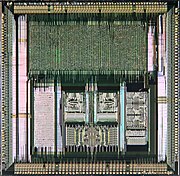Carver Mead | |
|---|---|
Mead in 2002 | |
| Born | Carver Andress Mead May 1, 1934 Bakersfield, California, U.S. |
| Awards | Kyoto Prize (2022) National Medal of Technology 2011 BBVA Foundation Frontiers of Knowledge Award Computer History Museum Fellow (2002) |
| Scientific career | |
| Thesis | Transistor Switching Analysis (1960) |
| Doctoral advisor | R. D. Middlebrook Robert V. Langmuir |
| Doctoral students | Kwabena Boahen |
| External videos | |
|---|---|
 | |
Carver Andress Mead (born 1 May 1934) is an American scientist and engineer. He currently holds the position of Gordon and Betty Moore Professor Emeritus of Engineering and Applied Science at the California Institute of Technology (Caltech), having taught there for over 40 years.[1]
A pioneer of modern microelectronics, Mead has made contributions to the development and design of semiconductors, digital chips, and silicon compilers, technologies which form the foundations of modern very-large-scale integration chip design. Mead has also been involved in the founding of more than 20 companies.[2]
In the 1980s, Mead focused on electronic modeling of human neurology and biology, creating "neuromorphic electronic systems."[3][4][5] Most recently, he has called for the reconceptualization of modern physics, revisiting the theoretical debates of Niels Bohr, Albert Einstein and others in light of later experiments and developments in instrumentation.[6]
Mead's contributions as a teacher include the classic textbook Introduction to VLSI Systems (1980), which he coauthored with Lynn Conway. He also taught Deborah Chung, the first female engineering graduate of Caltech,[7] and advised Louise Kirkbride, the school's first female electrical engineering student.[8][9]
- ^ "Carver Mead 2002 Fellow". Computer History Museum. Archived from the original on March 8, 2013. Retrieved June 4, 2015.
- ^ Cite error: The named reference
Bush2003was invoked but never defined (see the help page). - ^ Furber, Steve (2016). "Large-scale neuromorphic computing systems". Journal of Neural Engineering. 13 (5): 051001. Bibcode:2016JNEng..13e1001F. doi:10.1088/1741-2560/13/5/051001. PMID 27529195.

- ^ Cite error: The named reference
Newellwas invoked but never defined (see the help page). - ^ Marcus, Gary (November 20, 2012). "The Brain in the Machine". The New Yorker. Retrieved June 8, 2015.
- ^ Cite error: The named reference
Spectator2001was invoked but never defined (see the help page). - ^ "Forty-Five Years Since Their Graduation, Three of Caltech's First Female BS Recipients Look Back". Archived from the original on July 7, 2020. Retrieved March 10, 2021.
- ^ Cite error: The named reference
Liferwas invoked but never defined (see the help page). - ^ "Louise Kirkbride | Lemelson". lemelson.mit.edu. Retrieved December 1, 2021.